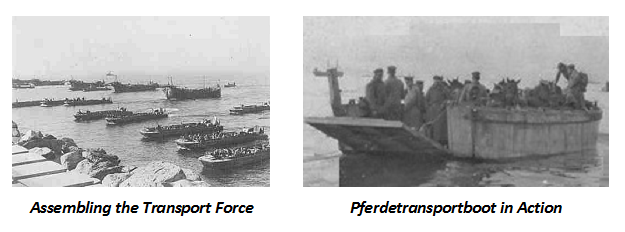Zeitschrift für Heereskunde – Amphibious Craft of the Great War
Not long after the turn of the century the Imperial Army began a series of developments to address the issue of landing troops over undefended beaches. This interest was prompted by the growing tensions between Germany and Tsarist Russia as much as by the ongoing naval rivalry between Germany and Great Britain. The first tests were begun in 1903 near the East Frisian island of Mellum with limited success (1) but were followed up over the next several years which saw development of a standard transport craft capable of use in extended river crossings or in ship-to-shore landings.
Known as the
Pferdetransportboote – or Horse Transport Boat – the army craft was non-motorised and intended to be hauled ashore on a cable connection, a so-called
Landungstrossen, or towed by a motor boat. The decision to use the cable connection stemmed from several factors – the familiarity of Army pionier troops with such equipment being the stated reason – but many have speculated that the true reason was the poor reaction of the Army’s horses to the noise and fumes of the engines available at the time.
The craft itself was 10.5 metres long and 3.4 metres wide; to keep the draft as low as possible, the bottom of the boat was manufactured from a series of sealed cells. The
Pferdetransportboote weighed 10 tons and could accommodate ten tons of cargo, which corresponded to eight to ten horses, two field guns, a field howitzer with limber, a motor truck, or seventy fully-equipped infantrymen. The first examples were supplied to pionier units attached to the I Army Corps of the Prussian Army in 1908.
Continued experimentation led to joint efforts with the
Kaiserliche Marine, which had a minor interest in such vessels due to its need for naval landing parties and securing coaling stations abroad. Efforts focused on the design of a steel-hulled, self-propelled craft of larger capacity, derived initially from flat-bottomed river barges. The first prototypes of such a craft were constructed by Gebrüder Sachsenberg of Roßlau and were first tested at Mellum in 1910 (2).
Designated
Marine Nachschub Leichter – or Naval Supply Barge – the prototypes were followed up by a small series of craft employed by the
Kaiserliche Marine chiefly as supply craft between naval stations on the shallow Kurisches Haff. The craft were 42.7 metres long at the waterline, but 54.7 metres long overall, with a beam of 6.6 metres and a draught of only 1.2 metres. They were powered by Germaniawerft diesel engines of 100 PS, each connected to a separate shaft, and were capable of a speed of five knots. Displacing 225 tonnes, the craft were intended to carry up to five hundred troops over a short distance, or the equivalent cargo. When employed as landing craft, egress was via bow ramp lowered with the help of a pair of booms at the bow.
At the outbreak of hostilities in August 1914 the
Pferdetransportboot was in regular service with many of the Imperial Army’s pionier units, though they saw little employment during the opening moves in the West. The small number of naval supply barges – numbering only seven units – were stationed in East Prussia and used initially as coal barges, there being little call for landing craft at that stage of the war. By mid-1915 however, this situation had changed. The involvement of German units in support of the Austro-Hungarian Army in the Balkans saw the Army’s
Pferdetransportboot in regular use as ferries on the Danube, while operations against Russian forces saw numerous river crossings made possible by the now-ubiquitous craft. Once Russian forces were cleared from Courland by the advance if the Imperial Army the
Kaiserliche Marine found itself called upon to ferry supplies to the small ports of Libau and Windau, and discovered that the
Marine Nachschub Leichter, with its shallow draft and ability to unload without use of port facilities, was quite useful in this role, and an additional series of twelve craft was ordered from the Schichau works in the autumn of 1915.
This role of supplying the advancing armies on the Eastern Front would cause the
Kaiserliche Marine to create a third type of landing vessel – an adaptation of a coastal cargo ship, known as the
Mehrzweck Tross-schiff, or Multi-purpose Supply Ship. Displacing more than 1,000 tons, these steamers were more than 74 metres long, 10.4 metres in the beam and drew 1.8 metres of water when fully loaded. Their steam engines could propel them at 10 knots, and their four commodious holds could hold men, equipment or supplies for a short journey. While not intended for beaching operations, they could land troops by means of two 7-metre gangplanks carried at the bow and deployed by means of a bowsprit boom.
These strands came together in the autumn of 1916 during
Unternehmen Albion, the capture of the Russian-held Baltic islands of Ösel, Moon, and Dagö. This strategic coup was carried out by the reinforced 42nd Division supported by all the landing craft both the Imperial Army and the Kaiserliche Marine could muster, together with requisitioned civilian steamers. On the morning of 12 October 1916 troops were landed at Tagga Bay, quickly over-running Ösel; subsequent landings cleared remaining Russian forces from Moon and Dagö, opening the Gulf of Riga. This in turn allowed the Imperial Army to break through Russian defences along the river Düna and begin its drive on St. Petersburg.
With Germany’ defeat in the Great War the amphibious landing capability built up by both services was perforce lost. This did not, of course, mean that interest in amphibious landing was totally lost. Several staff officers of the former Imperial Army were retained as part of the
Truppenamt in the immediate aftermath of hostilities, charged with historical research. Together with their naval counterparts they kept alive the memory of what had been accomplished. They also began the study of foreign developments in the amphibious arts, particularly in Russia and in France. In the late 1930s Germany would again begin development of specialist craft and accompanying vessels that would again give the
Heer and the
Kriegsmarine the ability to carry out landings on a far more sophisticated scale.
(1) These developments were observed and reported upon by the British intelligence services at the time but their importance was not fully understood. A fictionalised account of these activities appeared in print as The Riddle of the Sands by the novelist-cum-intelligence agent Erskine Childers.
(2) The testing of landing craft at Mellum were noted and reported by Captain Bernard Trench RM and Lieutenant Vivian Brandon RN, who were cruising the area while posing as amateur yachtsmen. Both would later join British naval intelligence’s unit Room 40.

Quoted
I was referring to the Labrador Sea station. Not the German Pacific Squadron






